Novel function of keratins 5 and 14 in proliferation and differentiation of stratified epithelial cells
- PMID: 21900500
- PMCID: PMC3204069
- DOI: 10.1091/mbc.E10-08-0703
Novel function of keratins 5 and 14 in proliferation and differentiation of stratified epithelial cells
Abstract
Keratins are cytoplasmic intermediate filament proteins preferentially expressed by epithelial tissues in a site-specific and differentiation-dependent manner. The complex network of keratin filaments in stratified epithelia is tightly regulated during squamous cell differentiation. Keratin 14 (K14) is expressed in mitotically active basal layer cells, along with its partner keratin 5 (K5), and their expression is down-regulated as cells differentiate. Apart from the cytoprotective functions of K14, very little is known about K14 regulatory functions, since the K14 knockout mice show postnatal lethality. In this study, K14 expression was inhibited using RNA interference in cell lines derived from stratified epithelia to study the K14 functions in epithelial homeostasis. The K14 knockdown clones demonstrated substantial decreases in the levels of the K14 partner K5. These cells showed reduction in cell proliferation and delay in cell cycle progression, along with decreased phosphorylated Akt levels. K14 knockdown cells also exhibited enhanced levels of activated Notch1, involucrin, and K1. In addition, K14 knockdown AW13516 cells showed significant reduction in tumorigenicity. Our results suggest that K5 and K14 may have a role in maintenance of cell proliferation potential in the basal layer of stratified epithelia, modulating phosphatidylinositol 3-kinase/Akt-mediated cell proliferation and/or Notch1-dependent cell differentiation.
Figures

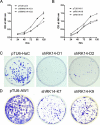
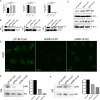
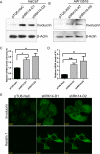
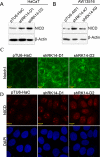

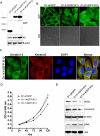
References
-
- Alam H, Kundu ST, Dalal SN, Vaidya MM. Loss of keratins 8 and 18 leads to alterations in alpha6beta4-integrin-mediated signalling and decreased neoplastic progression in an oral-tumour-derived cell line. J Cell Sci. 2011;124:2096–2115. - PubMed
-
- Albers KM. Keratin biochemistry. Clin Dermatol. 1996;14:309–320. - PubMed
-
- Alessi DR, James SR, Downes CP, Holmes AB, Gaffney PR, Reese CB, Cohen P. Characterization of a 3-phosphoinositide-dependent protein kinase which phosphorylates and activates protein kinase Bα. Curr Biol. 1997;7:261–269. - PubMed
-
- Allenspach EJ, Maillard I, Aster JC, Pear WS. Notch signaling in cancer. Cancer Biol Therapy. 2002;1:466–476. - PubMed
-
- Bray SJ. Notch signalling: a simple pathway becomes complex. Nat Rev. 2006;7:678–689. - PubMed
Publication types
MeSH terms
Substances
LinkOut - more resources
Full Text Sources
Other Literature Sources
Molecular Biology Databases
Research Materials
Miscellaneous

